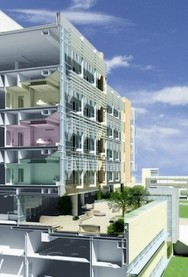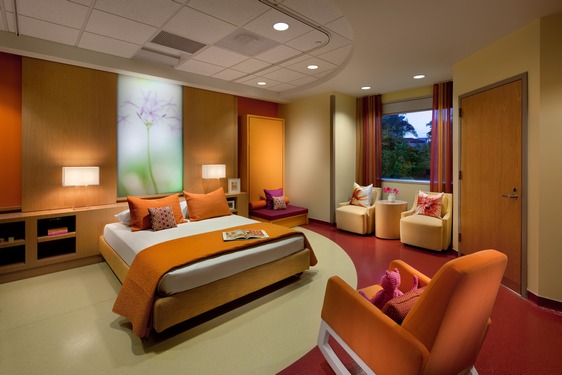Subscribe Now
New Frontiers – Exploring Options of Prefabrication in Healthcare
 Though it is generally thought of as a postmodern concept, prefabrication, commonly referred to as prefab, is a construction technique that is evident throughout history: from the 60-ton columns of the Roman Pantheon, which were quarried in Egypt to England’s “Manning Portable Cottages,” constructed in England and shipped to the Australian colonies. Often referred to as “architecture’s oldest new idea,” prefabrication seems to come in vogue when economies become strained.
Though it is generally thought of as a postmodern concept, prefabrication, commonly referred to as prefab, is a construction technique that is evident throughout history: from the 60-ton columns of the Roman Pantheon, which were quarried in Egypt to England’s “Manning Portable Cottages,” constructed in England and shipped to the Australian colonies. Often referred to as “architecture’s oldest new idea,” prefabrication seems to come in vogue when economies become strained.
By definition, prefabrication is a process by which components are pre-constructed in a workshop setting, then transported and assembled onsite. Throughout history, many architects and engineers have turned to prefabrication — sometimes with great success — to answer the demands of a growing consumer population. Indeed, modulation and prefabrication have served manufacturing and commercial industries exceedingly well. Think of the success of Ford (one of the oldest companies in prefabrication) and IKEA. Yet the prefab craze, which has proven to be so incredibly successful in other industries, has never been fully embraced by the architectural industry. And one must wonder why. Perhaps it is because prefab embodies efficiency and standardization, and the complexities of a large-scale, multi-trade building process seem too daunting a process to standardize. Perhaps it is because the default application for prefab has historically been housing projects; ironic when one considers how personal and intimate a home is to its owner. Whatever the reason, there is an architectural application that seeks to reduce customization and applauds standardization: healthcare.
Healthcare architecture and prefabrication is a perfect paring. What spatial environment calls for more design standardization than the modern hospital? Consider the list of typical spaces in healthcare facilities whose designs are standardized and defined by exacting codes and operational-oriented parameters: inpatient rooms, outpatient exam rooms, offices, laboratory spaces, operating rooms, pre- and post-op spaces, nurse stations, PACU spaces…the list goes on. These examples of prefabrication in healthcare are still relatively limited, especially in the United States.
 Many instances are implementations of prefab on a somewhat micro scale, but do address some key components in the patient care areas. In addition, several manufacturers offer standardized customization of patient headwalls, footwalls, casework and other standard systems that are commonplace. More intriguing examples of prefab in healthcare are surgical and imaging equipment manufacturers that market room modules installed onsite. But perhaps the most publicized case study is Miami Valley Hospital in Dayton, Ohio. The design team engaged not only the standard fare of prefab components (such as the casework, modular workstations and curtainwall), but also made innovative strides by prefabricating the patient room bathrooms, and the patient room headwalls. In an online video presentation, the architect describes the process of developing a same-handed patient room module with a prefabricated headwall “fin.” Each fin was delivered to the site and set into a recess in the concrete slab. The patient bathroom was also constructed as a modular unit that was delivered and installed onsite. Though this project was reportedly not able to achieve significant cost savings, the design team did boast a dramatic improvement in the quality of construction; in the reduction of onsite waste; in the enhanced working conditions and in the overall time-saving efficiency during construction. The standard logistical challenges of prefab, including storage and transportation, still apply and become even weightier in a complex (and expensive) endeavor such as a hospital. Though Miami Valley Hospital is undeniably groundbreaking, it is just the beginning of possibilities for prefab in healthcare.
Many instances are implementations of prefab on a somewhat micro scale, but do address some key components in the patient care areas. In addition, several manufacturers offer standardized customization of patient headwalls, footwalls, casework and other standard systems that are commonplace. More intriguing examples of prefab in healthcare are surgical and imaging equipment manufacturers that market room modules installed onsite. But perhaps the most publicized case study is Miami Valley Hospital in Dayton, Ohio. The design team engaged not only the standard fare of prefab components (such as the casework, modular workstations and curtainwall), but also made innovative strides by prefabricating the patient room bathrooms, and the patient room headwalls. In an online video presentation, the architect describes the process of developing a same-handed patient room module with a prefabricated headwall “fin.” Each fin was delivered to the site and set into a recess in the concrete slab. The patient bathroom was also constructed as a modular unit that was delivered and installed onsite. Though this project was reportedly not able to achieve significant cost savings, the design team did boast a dramatic improvement in the quality of construction; in the reduction of onsite waste; in the enhanced working conditions and in the overall time-saving efficiency during construction. The standard logistical challenges of prefab, including storage and transportation, still apply and become even weightier in a complex (and expensive) endeavor such as a hospital. Though Miami Valley Hospital is undeniably groundbreaking, it is just the beginning of possibilities for prefab in healthcare.
In our newly digitized industry there is a substantial untapped potential for precision in collaboration and execution. Because of the standardization sought in these spaces, typical patient care areas are the most logical places to accelerate prefab and mass-production. Instead of populating patient care spaces with an assortment of off-the-shelf products, could the patient care space itself become an off-the-shelf product? Consider, for example, the design and engineering of the inpatient room. Research and literature generated by the Evidence-Based Design movement is honing in on environmental design qualities that begin to define an ideal typical patient room.
A motivated team could effectively collaborate to design and engineer an idealized, prefabricated and mass-producible patient room module that serves as a general solution to almost any hospital. It could be the true realization of the “form follows function” mantra. The module becomes a marketable off-the-shelf product with benefits including cost savings, time savings and superior quality. Consider shopping for a patient room the way you would an automobile: “Do you want an SUV or a compact? Do you want a trim upgrade or is the standard model acceptable? You need an after-market customization, no problem; we can work that into your package.” In this scenario, the patient room becomes a product the design team selects to meet certain specifications and performance features.
Prefabrication is a design and construction strategy that is underutilized in the healthcare design industry. The needs of every client are in some ways unique and in many ways universal. Though small steps forward are being made, the frontier is still wide open in regard to the potential for prefabrication and mass-production in healthcare design and construction.
Sarah Wade Walter is a graduate of Clemson University’s Master of Architecture + Health Studio. She is a lead healthcare designer at Stanley Beaman & Sears. SBS is a “big idea” firm and is known nationally for its inventive and innovative designs for pioneering projects in healthcare. She may be reached at sarah.walter@sbs-architecture.com or 404-524-2200.
To learn more about the Miami Valley Hospital, visit www.nbbj.com/presentations/MVH_Prefab.
To learn more about the facilities mentioned in the images (Children’s Healthcare of Atlanta at Egleston or the Nemours Children’s Hospital), visit www.sbs-architecture.com.
Tags:
Posted September 19, 2012
More Articles:
- Coverings 2024
Apr 22, 2024 – Apr 25, 2024 - Hospital, Outpatient Facilities & Medical Office Buildings Summit
Apr 25, 2024 – Apr 25, 2024 - CxA Workshop & Exam
Apr 29, 2024 – Apr 30, 2024 - EMP Seminar & Exam at CxEnergy 2024
Apr 29, 2024 – Apr 30, 2024 - CxEnergy
Apr 29, 2024 – May 2, 2024 - PHCC West 2024
Apr 29, 2024 – May 2, 2024 - Lean in Design Forum 2024
May 1, 2024 – May 2, 2024










